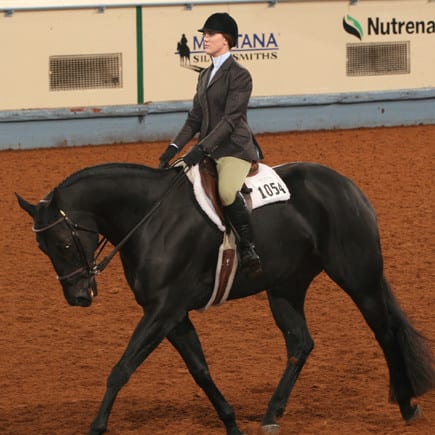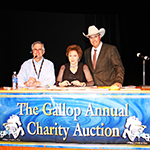Editor’s Note: This 2015 article was one of the biggest hits on our site. Diagonals have always been a hot topic. Many riders have difficulty feeling them without looking down. Trainer Holly Hover discusses many ways riders can learn their diagonals. If you missed it or have trouble with diagonals, this article is for you.
It’s a well known fact that one of the hardest maneuvers for equestrians to learn is how to pick up the correct diagonal. For some, mastering this skill wasn’t too difficult, others are still left struggling.
We’ve all learned since we first sat in an English saddle that being on the correct diagonal is important, but for equestrians who compete in Hunt Seat Equitation, we’ve learned that having mastership of the skill is monumental.
Why?
Because at some point in every Hunt Seat Equitation pattern, an exhibitor will be required to demonstrate that they can pick up a correct diagonal.
And at some point in every rider’s life, they will pick up the wrong one.
In today’s show pen, picking up an incorrect diagonal is the kiss of death as it is considered a major, or severe, penalty (depending on the situation). Therefore, it is a very important element to achieving success in a Hunt Seat Equitation class.
Gohorseshow sat down with AQHA horsewoman and judge Holly Hover to discuss why diagonals play such a huge role in Hunt Seat Equitation, how to never look down again, and how to perfect your diagonals once and for all!
Why Diagonals are Important
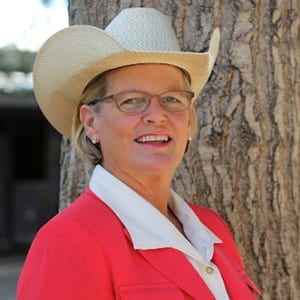 As a rider and exhibitor, you may or may not know why diagonals are important or why we are tested on them in a Hunt Seat Equitation class.
As a rider and exhibitor, you may or may not know why diagonals are important or why we are tested on them in a Hunt Seat Equitation class.
Hover explained, “Hunt Seat Equitation on the flat is really a prelude to Equitation over Fences. In that class, you are tested on your balance with the horse, and in order to be successful you have to know where your horse’s legs are.”
She expounded that in Hunt Seat Equitation we are tested on diagonals to assure the judge that we know where our horse’s legs are and can demonstrate balance with our horse. In other words, by knowing our diagonals, we are demonstrating that we can stay in the saddle over fences.
“When you are on the wrong diagonal, you are out of balance with the horse,” she said.
Hover went on to discuss the mistakes people make in the show pen when it comes to diagonals and how it can affect an exhibitor’s score.
“Worst case scenario is first looking for your diagonal and then missing it. This is a double penalty application.” Hover continued, “A major penalty for obviously looking for your diagonal, and a judge can give either a major or severe penalty for a missed diagonal (depending on how many strides are involved). These scenarios are a wrecking ball for your score.”
It is a major fault to look for your diagonal but still manage to pick up the correct one.
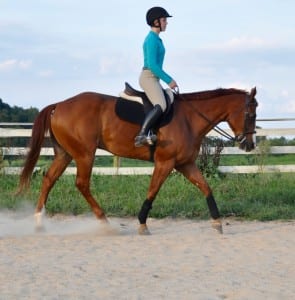 “When it comes to a penalty situation, diagonals are very important,” said Hover, “Let’s say an exhibitor is nearly perfect, earning a score in the 90’s, and then misses a diagonal. Their score just takes a major hit as it must drop at least two scoring ranges and may be dropped even further. That mistake turns an excellent score into an average score at best.”
“When it comes to a penalty situation, diagonals are very important,” said Hover, “Let’s say an exhibitor is nearly perfect, earning a score in the 90’s, and then misses a diagonal. Their score just takes a major hit as it must drop at least two scoring ranges and may be dropped even further. That mistake turns an excellent score into an average score at best.”
Hover said what judges are really testing exhibitors on is their ability to “feel.” (pictured left rider on correct/outside diagonal)
“A great attribute in a Hunt Seat Equitation rider is having feel,” she said, “because if you don’t have feel, what do you really have as an equestrian?”
According to Hover, being able to pick up a correct diagonal without looking, shows the judge you have, as she calls it, “the complete package.”
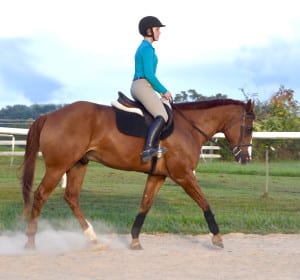 Riders who look down for their diagonals or miss them, show judges, well, a different package.
Riders who look down for their diagonals or miss them, show judges, well, a different package.
“When we see a rider look down for their diagonal, it is a dead giveaway to the judge that that rider doesn’t have the feel of the horse,” Hover said.
It can also prove problematic for the rest of the pattern.
Hover said, “Riders who look down, draw their horses down, which makes it more difficult for the rider to get to their next maneuver.”
Bottom line: Nailing one’s diagonals will do nothing but elevate your score. Missing them will do nothing but destroy it. (pictured right–rider on inside/incorrect diagonal)
How to “Get It” at Home
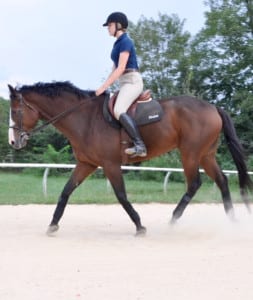 Every person can probably recall a time during a lesson when their trainer has yelled out something along the lines of “Wrong!” or “Change!” alerting you that you are on the wrong diagonal.
Every person can probably recall a time during a lesson when their trainer has yelled out something along the lines of “Wrong!” or “Change!” alerting you that you are on the wrong diagonal.
You may have been embarrassed, maybe even said, “I know!” but in order to really learn one’s diagonals, Hover said you need to “leave your ego at the door.”
“You really need to humble yourself, get honest with yourself, and ride through it,” she said, “have someone help you get this. Because once you get it, you have it.”
To really help riders understand the mechanics of a diagonal, Hover likes to use the old adage “rise and fall with the leg on the wall,” which means that riders must learn the foot fall of the outside leg. (pictured left–outside front leg coming forward)
“Learning diagonals is really about learning how to feel the horse’s leg go forward and around, and then strike the ground,” she said, “a rider needs to feel the complete revolution.”
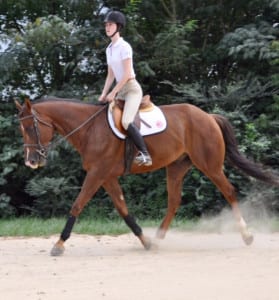 Hover reminds riders that a horse’s leg actually moves in a circular motion through the shoulder and a rider must learn to follow this motion to establish balance with the correct diagonal.
Hover reminds riders that a horse’s leg actually moves in a circular motion through the shoulder and a rider must learn to follow this motion to establish balance with the correct diagonal.
“Think of the shoulder moving like a piston: down, back, up, forward,” she said, “this is what propels the horse across the ground. It is important to be able to recognize each piece of this revolution and follow the motion of the outside leg. The correct diagonal rises with the leg and rides through the forward rotation.”
To further one’s understanding of this concept (and ultimately understand diagonals), Hover offered some valuable exercises to try at home.
She recommends having the rider call out (or the ground person, depending on how much help the rider needs) each time the horse’s front hoof strikes the ground. Once the rider is successfully calling out each time the horse’s front hooves strike the ground, Hover suggests adding calling out when the horse’s leg is departing the ground. This way the rider is learning to feel the complete revolution of the horse’s legs.
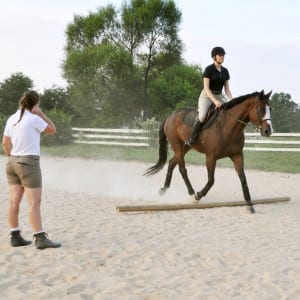 Another exercise Hover recommends is using a trail pole. Yes, a trail pole just like the one pictured left.
Another exercise Hover recommends is using a trail pole. Yes, a trail pole just like the one pictured left.
“I’ve seen this really help people who just have a really hard time getting it just going around the arena,” she said.
“Because a horse has to step up and over the pole, the rider can then really feel which leg is going up and forward and which one is coming down.”
Hover recommends starting out about 4-5 strides away from the pole. At three strides away, a ground person calls out which leg they want to cross over the pole first. The rider then must concentrate on the movement of the horse in order to ensure the proper leg crosses over the pole.
For both the aforementioned exercises, Hover recommends mastering the skills at the walk first before trying it at the trot.
One Last Thing…
There are some people who insist on trying to cheat when it comes to looking for a diagonal.
They think they have mastered the skill of well, cheating.
They are certain no one, not even the judge in the stands, can see them peeking.
Hover had some great advice on the subject, “Don’t try to cheat because then you’ll never learn it. Don’t cheat your trainer, don’t cheat yourself. Definitely don’t try to cheat with your eyes. Judges see you, we really do.”
About the Author: A Tucson, Arizona native Chenay Jordan-McDowell started riding Pony Hunters at six years old until she found a passion for Paint horses in 1993. In 2000, Chenay stopped showing to focus on scholastics. She went on to graduate from the University of Arizona in 2006 with a dual Bachelor of Arts in English and Creative Writing. Today, she lives in Yucaipa, California with her husband, son, and eight animals, including a rescued APHA mare. Between being a wife and mother, she teaches English as a foreign language and is a freelance writer.
Photos © Sarah Elder Chabot


